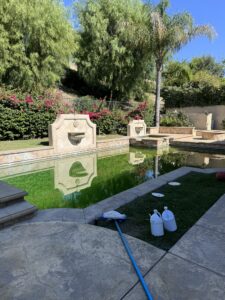balancing pool chemistry in
simi valley
Maintaining balanced pool water chemistry is one of the most important aspects of keeping a swimming pool clean, safe, and enjoyable. Properly balanced water not only ensures a comfortable swimming experience but also protects the pool’s surfaces and equipment from damage. Many pool owners in Simi Valley rely on SoCal Poolfection for expert guidance in keeping their pool water chemistry in perfect balance. Understanding the key components of pool chemistry, how they work together, and how to make adjustments when necessary can make a big difference in maintaining a crystal-clear swimming pool.
One of the most critical elements of pool chemistry is pH, which measures how acidic or basic the water is. The ideal pH range for a swimming pool is between 7.2 and 7.6. If the pH level is too low, the water becomes acidic, which can cause skin and eye irritation, corrode pool equipment, and damage surfaces. On the other hand, if the pH is too high, the water can become cloudy, and chlorine becomes less effective at sanitizing the pool. Regularly testing the water and adding the appropriate chemicals to maintain a stable pH is essential for a well-balanced pool.
Closely related to pH is alkalinity, which acts as a buffer to help prevent sudden changes in pH levels. Alkalinity should be maintained between 80 and 120 parts per million (ppm) to keep the water stable. When alkalinity is too low, the pH can fluctuate dramatically, making it difficult to keep the pool chemistry balanced. When alkalinity is too high, it can lead to scaling and cloudy water. Adding baking soda can raise alkalinity levels, while adding acid can help lower it when necessary. Keeping alkalinity within the proper range makes it easier to manage pH levels and maintain a comfortable swimming environment.
Chlorine is another essential factor in pool water chemistry. It is the primary sanitizer used to kill bacteria, viruses, and algae, keeping the pool water clean and safe. The recommended chlorine level for a pool is between 1 and 3 ppm. If the chlorine level is too low, bacteria and algae can quickly take over, turning the water green and making it unsafe for swimming. If the chlorine level is too high, it can cause strong chemical odors, irritate swimmers’ skin and eyes, and damage pool surfaces. Regularly testing chlorine levels and adjusting them as needed helps maintain a sanitary swimming environment.
Stabilizer, also known as cyanuric acid, plays an important role in protecting chlorine from being broken down by sunlight. Without stabilizer, chlorine can quickly degrade, requiring frequent additions to keep the pool properly sanitized. The recommended stabilizer level for a pool is between 30 and 50 ppm. If stabilizer levels are too low, chlorine will dissipate too quickly, making it harder to keep the water clean. If stabilizer levels are too high, chlorine becomes less effective, leading to potential water quality issues. Pool owners in Simi Valley often rely on SoCal Poolfection to help them find the right balance of stabilizer to maximize the effectiveness of their chlorine while keeping their pool water clear.
Acid is commonly used to lower pH and alkalinity levels when they become too high. Muriatic acid and dry acid are the two main types used in pool maintenance. It is important to add acid carefully and in the right amounts to avoid drastic changes in pool chemistry. When adding acid, it is recommended to pour it slowly into the deep end of the pool while the pump is running to help distribute it evenly. Understanding how and when to use acid properly helps prevent scaling and keeps the water comfortable for swimmers.
Regular water testing is the key to maintaining balanced pool water chemistry. Pool owners should test their water at least once or twice a week using test strips or liquid test kits. This allows them to monitor pH, chlorine, alkalinity, and stabilizer levels and make adjustments as needed. If water chemistry is left unbalanced for too long, it can lead to serious problems, including cloudy water, algae growth, and equipment damage. Consistent testing and adjustments help prevent these issues and keep the pool in top condition year-round.
Another factor that affects pool chemistry is the presence of contaminants such as sweat, sunscreen, and debris from the environment. These contaminants can introduce unwanted bacteria and alter the chemical balance of the water. Regularly skimming the pool, using a pool cover when not in use, and encouraging swimmers to rinse off before entering the pool can help reduce the amount of contaminants in the water, making it easier to maintain proper chemical levels.
In addition to chemical balancing, proper pool circulation is crucial for maintaining clear and clean water. Running the pool pump for the recommended amount of time each day ensures that chemicals are evenly distributed throughout the pool. Poor circulation can lead to dead spots where algae and bacteria can thrive, making it more difficult to keep the water balanced. Ensuring that return jets are positioned correctly and that the pump and filter are functioning properly helps improve circulation and overall water quality.
Shock treatments can also help maintain balanced pool water chemistry, especially after heavy use or following rainstorms. Shocking the pool involves adding a high dose of chlorine or a non-chlorine oxidizer to eliminate contaminants, break down organic waste, and restore chlorine levels. This process helps keep the water clear and prevents the buildup of unwanted bacteria and algae. It is recommended to shock the pool every one to two weeks, depending on usage and environmental conditions.
Balancing pool water chemistry is an ongoing process that requires regular attention and care. By keeping pH, alkalinity, chlorine, and stabilizer levels within the proper ranges, pool owners can ensure a safe and enjoyable swimming experience. Those who need assistance with maintaining their pool’s chemistry can rely on SoCal Poolfection in Simi Valley for professional advice and services. With proper care and expert guidance, keeping a pool in perfect balance becomes a simple and rewarding task, allowing homeowners to enjoy clean, refreshing water all season long.



Hi, this is a comment.
To get started with moderating, editing, and deleting comments, please visit the Comments screen in the dashboard.
Commenter avatars come from Gravatar.